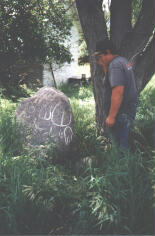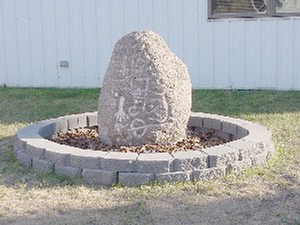 inches around and sat overlooking a burial ground [B:4]. Early
pioneers sometimes saw Native Americans gathered at the rock,
engaged in religious ceremonies [B:4]. The landowner moved it
out of the way so he could plant crops and farm.
inches around and sat overlooking a burial ground [B:4]. Early
pioneers sometimes saw Native Americans gathered at the rock,
engaged in religious ceremonies [B:4]. The landowner moved it
out of the way so he could plant crops and farm.
In our modern worship there is a song that includes the
words "Rock of Ages." Sitting on a bluff above Turtle River at
the confluence of Wolf Creek was an ageless rock west of Tulare,
South Dakota [A]. The rock is four feet tall and ninety-nine
 inches around and sat overlooking a burial ground [B:4]. Early
pioneers sometimes saw Native Americans gathered at the rock,
engaged in religious ceremonies [B:4]. The landowner moved it
out of the way so he could plant crops and farm.
inches around and sat overlooking a burial ground [B:4]. Early
pioneers sometimes saw Native Americans gathered at the rock,
engaged in religious ceremonies [B:4]. The landowner moved it
out of the way so he could plant crops and farm.
Imagine for a moment the confusion that would arise today in eastern South Dakota if a UFO landed and aliens saw us. They might observe people gathered around an altar and report that we were engaged in a religion ceremony too. Natives of eastern South Dakota were as baffled by white Europeans as we would be if approached by aliens from the UFO.
A wide range of differences would separate us from anyone able to construct a spaceship and come for a visit from a galaxy far away. White Europeans found people in eastern South Dakota who seemed very strange, being unable to read or write and speaking unknown tongues.
The rock near Tulare was moved from its original location and that act desecrated it. Never again could it be used by Native Americans for religious purposes [C:303]. Nobody got upset. Times had changed when the landowner moved it and most Native Americans were gone from the area.
Native oral tradition contains the legend of Wakan, translated as Thunderbird or Thunderbeing, the major Dakota deity. When the bird or deity landed on a rock, marks would be left [C:290]. That could account for the untranslatable marks on the Tulare rock.
If aliens from the UFO were to violate the "Prime Directive" made popular by that TV series Star Trek, we might likewise develop strange oral traditions. In the event we had abandoned our religious practices by then, our great-great-grandchildren might try to remember stories about tall structures and steeples with crosses on top. The truth they would be trying to tell visitors from afar might sound as strange as whatever went on around that rock west of Tulare.
The Tulare rock is a granite boulder spewed up by a glacier in some past ice age [C:289]. It is very durable and will not weather, not in our lifetime, as it did not in many past lifetimes.
It is not eligible for listing in the National Register of Historic Places because it was moved and is still on private land [C:380]. Several suggestions have been made for its ultimate resting place. Some want it put in Tulare for public viewing and a fence built around it [A]. Others have suggested the Museum at Redfield would be the right place. Perhaps a fund could be raised to defer the cost.
Either location could be justified. Moreover, it should be just fine outside where the public could be educated by its story.
Two very important considerations arise about what to place on the inscription. First and foremost, the right things should be said about the rock and how it fit into early human life in eastern South Dakota. Second, and just as important, there is the story about the landowner who found the rock. It will be a fitting tribute to two cultures, Native American and white European people.
Engraving the inscription to meet those two goals can be accomplished through cooperation between the South Dakota Historical Preservation Center and families still living near Tulare who know the rock's history.
Native Americans are honored when the story of their ancestors is placed in the proper context for public education [C:326]. One definition of history is the written record of mankind's thoughts and actions. This rock at Tulare communicates both.
Let this essay stand as the first contribution toward a fund to honor the rock of ages at Tulare, South Dakota.
Volunteers moved the historic stone into Tulare on August 17, 2002 and placed it in front of the Community Building on Main Street. The grooved pictures of several hands and some unusual markings can be seen from the street because the durable rock is over four feet tall.

References
[A]
Interviews with
Gordon Hull, author of
"Dakota Venture",
Published 1989 by
Hayes Printing Co.,
Aberdeen, SD 57401
[B]
Leta Anne Nolan, Project Director
"History of the Spink County Area",
Published 1989 by
Curtis Media Corp.,
Dallas, TX 75207
[C] Linea Sundstrom, Ph. D. "Fragile Heritage: Prehistoric Rock Art of South Dakota", Published 1993 by South Dakota Historical Preservation Center, Vermillion, SD 57069
* * *

 RETURN TO MAIN PAGE
RETURN TO MAIN PAGE